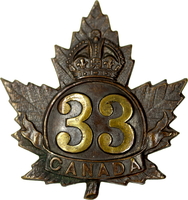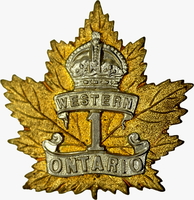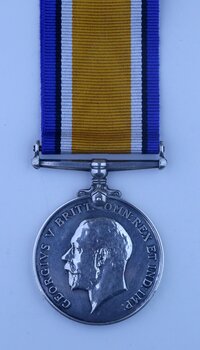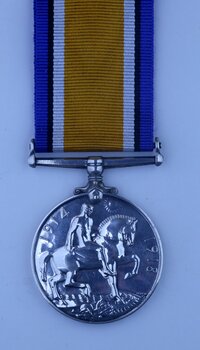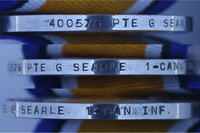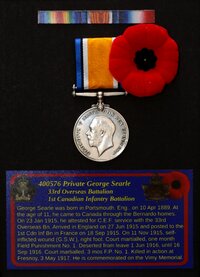
400576 Private George Searle
33rd Canadian Overseas Battalion
1st Canadian Infantry Battalion
By: Capt (ret'd) Michael M. O'Leary, CD, The RCR
George Searle was born in Landport-Portsmouth, England, on 10 Apr 1889.
A Barnardo Boy from Dr. Barnardo's Home (for orphans) in England, Searle arrived in Canada via the ship S.S. Tunisian which made port at Portland, Maine, on 1 Apr 1901. Searle continued his journey to arrive in Canada at the dispersal home in Toronto was placed with the Heilmann farm at Rodney, Ontario. About 80,000 orphans and other pauper children were sent from England to Canada between 1880 and 1930 for "opportunity." Of this total, Dr. Barnardo sent about 30,000 of them.
Within months of his arrival in Canada, 11-year-old Searle appears in the 1901 Canadian census. He is recorded as a servant in the home of Balthasar (44) and Josephine (41) Heilmann.
By the time of the 1911 census, Searle has left the Heilmann's farm. In 1911, he is one of six boarders in the home of Mrs. Hulda Shipway in St. Thomas, Ontario. He and two of the other boarders were employed by the city as labourers. Two of Mrs. Shipway's teenage sons are also living at home, totalling eight young men in their teens and 20s under her roof. Mrs. Shipway's husband had died in 1904, leaving her to run a boarding house to support herself and her family. She would die a year after the census in May 1912.
On 23 Jan 1915, Searle attested for service in the Canadian Expeditionary Force (C.E.F.) with the 33rd Overseas Battalion at St. Thomas, Ont. A 25-year-old farmer, Searle was described on his attestation paper as 5 feet 4 1/2-inches tall, with a 36 1/2-inch chest, a fair complexion, blue eyes, and red hair. His religious denomination was Presbyterian. Searle identified Mrs. B. Hielmann, R.R. No. 2, Rodney, Ont., as his next of kin (she is noted in his records simply as a "Friend"). On attesting with the 33rd Battalion, Searle was given the regimental number A76, which was later changed to the C.E.F. service number 400576.
The 33rd Battalion, C.E.F., authorized on 7 Nov 1914, was an infantry battalion recruited and mobilized in London, Ontario. The unit embarked for Great Britain on 1 Apr 1916 aboard the S.S. Lapland. Reinforcing Drafts recruited by the unit sailed on 17 Jul and 17 Aug 1915.
Searle's enlistment was noted in The St. Thomas Daily Times on 23 Jan 1915. A few days later, The Rodney Mercury, in its edition of Thursday 28 Jan 1915, shared with the community that "Henry Gray and George Searle, two Rodney boys enlisted in the 25th Regiment at St. Thomas. They left town on the mail train last Monday morning." The 25th Regiment was the local Militia unit in St Thomas. It is likely that their enlistment at the unit's armoury was mistaken for joining the local unit rather than with the Overseas Battalion being recruited in the area.
Searkle maintained his connections with the Heilmanns. The Rodney Mercury noted his visits on leave to the farm in both March and April on 1915. On 15 Jun 1915, Searle left the 33rd Battalion to proceed overseas. He sailed from Canada as a member of the 1st Reinforcing Draft the unit provided to support Canadian units already in France and Flanders. The 1st Reinforcing Draft of the 33rd Battalion left Halifax, N.S., on 17 Jul 1915 aboard the S.S. Scandinavian.
Arriving in England, Searle was taken on the strength of the 12th Reserve Battalion at Shorncliffe on 27 Jun 1915 and posted to No. 2 Company. The 12th Battalion, C.E.F., was an infantry battalion authorized on 10 Aug 1914, it sailed for England in September, 1914, where it was redesignated the 12th Reserve Infantry Battalion on 29 Apr 1915. As a Reserve battalion, the unit provided reinforcements for the Canadian Corps in the field until it was reduced during the summer of 1916 and ultimately dissolved. The unit's remaining troops were absorbed on 4 Jan 1917 into a new 12th Res. Bn. when the reserve infantry units of the C.E.F. were reorganized.
Searle had a brush with the military's justice system in August 1915. Absent for a day, he was summarily tried on 24 Aug 1915 and found guilty of the offence. He was admonished and forfeited one day's pay.
On 6 Sep 1915, Searle was transferred to the 1st Battalion in France. Once in France, he remained at the 3rd General Base Depot until 16 Sep 1915 when he proceeded to join the 1st Battalion, reaching the unit in the field on 18 Sep 1915.
The Battalion's War Diary reported on 19 Sep 1915 that "Reinforcements of 1 Officer and 29 Other ranks reported for duty." These men were probably held in the rear area at first as the battalion was relieved in the front trenches the following night and moved into Brigade Reserve at "PIGGERIES" on the west side of the Bois des Ploegsteert and north of the town of that name.
On 26 Sep 1915, Searle received his first introduction to the front line trenches when the 1st Battalion relieved the 4th Can. Inf. Bn. that afternoon. The War Diary reported a quiet tour and the battalion's trench strength was 25 officers and 861 other ranks.
The 1st Bn remained in the front line trenches until relieved on 2 Oct 1915 and rotated into Divisional Reserve from until 7 October and returned to the forward trenches the following day. This front line tour was marked by artillery registering trenches on both sides of No Man's Land. On the last day of the tour, 13 Oct 1915, the 1st battalion executed a demonstration consisting of artillery bombardment of the opposing trenches and a feint attack with smoke bombs. The German response of retaliatory artillery fire left the battalion with a casualty list of 16 killed and about 26 wounded. The War Diary noted "Trenches suffered considerable damage. Behaviour of troops admirable, though many of them had not been under serious shell fire before."
Relieved by the 4th Cdn. Inf. Bn. on 14 Oct 1915, the 1st Battalion returned to Divisional Reserve at Dranoutre. While the battalion was away from the front, Searle would be briefly hospitalized from 17 to 22 Oct 1915, suffering from rheumatic fever and diarrhoea.
Alternating front line tours with periods in Brigade or Divisional Reserve, Searle and the 1st Battalion would soon be back in the front line trenches. Relieving the 4th Battalion on the night of 20 Oct 1915, the next five days were reported as "Situation unchanged" with exchanges of artillery fire noted as "not very heavy."
After a period in Divisional Reserve from starting 27 Oct 1915, the 1st Battalion returned to the front lines on the night of 1 Nov 1915, holding their trenches until they returned to Brigade Reserve on 7 October. Four days of relative rest included bathing parades and instruction for the companies in the use of the "Tube pattern Smoke Helmet," the gas mask known as the PH helmet. The 1st Battalion returned to the front lines on the evening of 10 Nov 1915.
The following day, 11 Nov 1915, Searle was admitted to the Dressing Station of No. 2 CFA. He was injured, suffering from a self-inflicted wound (G.S.W.) of his right foot. Because of the cause of his injury, Searle was placed under arrest on and evacuated to the Special Hospital at Boescheppe. This hospital received injured men who were suspected or known to have self-inflicted injuries. If confirmed, they were also subject to court martial for their actions.
Although the full court martial records does not appear to have survived with Library and Archives Canada, the following note is included in Searle's service record:
"In confinement awaiting trial from 13 Nov 1915 to 25 Nov 1915. Tried and convicted by Field General Court Martial (F.G.C.M.) 14 Nov 1916 of "Neglect to the prejudice of good order and military discipline" (Carelessly wounding himself in the right foot), and sentenced to one month Field Punishment No. 1., 25 Nov 1915. Sentence confirmed by G.O.C. 2nd Army, dated 26 Nov 1915."
Field Punishment No. 1 consisted of extra work and drill and the penance of being secured standing to a fixed object for an hour or more each day.
Searle rejoined the 1st Battalion on 3 Feb 1916. The following month, on 2 Mar 1916, The Rodney Mercury published a casualty list that included: "Men from Rodney and Vicinity Serving the Empire … 1st Battalion … George Searle — wounded."
In March, 1916, Searle arrange for a special remittance of Assigned Pay to be sent to Canada. The recipient was Miss Lillian Desmond of St. Thomas, Ont. Searle sent her $40, over a month's pay at his rate of pay as a Private. There is no indication in his records of what Searle's relationship was to Miss Desmond.
Back with the battalion, Searle continued the the cycle of rotations in forward trenches, support trenches, and reserve positions that would characterize the infantry experience of the Great War. In may, 1916, his name came up for a leave rotation and he was authorized nine days leave in England commencing 22 May 1916.
Searle was expected back from leave on 30 May 1916 and his first day back on parade with his company should have been 1 Jun 1916. that did not happen. He was absent without leave. After three weeks' absence, he was considered a deserter and the battalion followed the administrative steps to remove him from their roll.
A Court of Inquiry was conducted on 1 Jul 1916. A Board of three officers declared that "Private G. Searle, Pioneer Section, 1st Canadian Battalion" had illegally absented himself since the 1st day of June 1916. The army form on which this was recorded (A.F.B. 122) included a lengthy list of weapons, clothing, equipment and necessaries which were missing with Searle. As a result of the Court of Inquiry, George Searle was declared a Deserter and struck off strength, effective 1 Jun 1916.
On 16 Sep 1916, two and one-half months after he should have been back in the ranks, Searle was apprehended. On that date, he was taken on the strength of the 36th Reserve Battalion at West Sandling, England, his records noting that he was on rejoining from desertion.
A month later, and still in custody, Searle was struck off the strength of the 36th Battalion on 13 Oct 1916 to be returned to the 1st Battalion in France. He was formally taken on the strength of the 1st Bn. The following day and arrived at the unit on 17 Oct 1916 to be held in close arrest until his court martial.
On 17 Oct 1916, the 1st Battalion was on a series of marches as the Canadian Corps shifted from the Somme to the Vimy Sector. It would not be until 29 Oct 1916, when the unit was in a period of Brigade Reserve south-east of Clarency from 26 to 28 Oct 1916. While in Reserve, the battalion provided daily working parties and it was an opportunity for the completion of unfinished administrative duties.
Searle's service record provides the brief standard entry for the conduct of a Field General Court Martial:
"In confinement awaiting trial from 20 Oct 1916 to 14 Nov 1916. Tried and convicted by Field General Court Martial (F.G.C.M.) 14 Nov 1916 of "When on active service, absent without leave" 1 Jun 1916, and sentenced to 3 months Field Punishment No. 1. Sentence confirmed by Lt. Col. G.C. Hodson, A/G.O.C. 1st Can. Inf. Bde."
In this case, the documents recording the details of the trial can be found in the papers held by Library and Archives Canada.
The court martial was established by the completion of a Form for Assembly and Proceedings of Field General Court Martial on Active Service. Authorized on 28 Oct 1916 by the Commander of the 1st Canadian Infantry Brigade, Brig.-General C.B. Hughes, a Court Martial was ordered to be convened to try Pte. George Searle for absence. The court consisted of a president, Maj. C.C. Bennett (4th Cdn. Bn) and two members, Capt. T.R. Coleman (1st Bn.) and Lieut S.H. Griffin (4th Bn.).
Convened on 14 Nov 1916, 400576 Pte. G. Searle, 1st Canadian Bn., was charged with "When on Active Service, Absent Without Leave." In response to this charge, Searle entered a Plea of "Not Guilty."
The first witness called by the Prosecution was Lieut. Henry Bolingbroke Morris of the 1st Cdn Inf Bn. His statement was as follows:
"On or about the 16th of May 1916 I was Orderly Room Sergeant of the 1st Can Bn. At Dickebusch a leave warrant was received for the accused which was handed to the accused on May 21st, 1916. The leave was for England and for a period of 9 days. The accused leave expired on 31st of May and he should have returned on the 1st of June but he did not. I next saw the accused on the 17th September 1916 when he was returned to the battalion as a prisoner. Between these dates I was employed as Orderly Sergeant to Sept 29 and from that date until the 17th Oct I was Acting Adjutant of the 1st Can. Bn. and the accused to my knowledge was not present with the Battalion during that period."
"I produce a certified copy of A.F.B. 115 (marked "A" signed by the President and attached to the proceedings).
"The accused was struck off the strength of the Battalion on Sept 25th, 1916, by Daily Orders Part II as a Deserter."
The noted Army Form B115 was the record of the Court of Inquiry that investigated and confirmed Searle's absence without leave from the 1st Battalion.
Following Morris' presentation for the prosecution, Searle declined to cross-examine him as a witness. That concluded the Prosecution's case and the Court Martial turned to the defence.
The defence also had a single witness, which was Searle:
"Prisoner states on oath:
"On the evening of 21st May 1916 I left on 9 days leave to England. On or about the 26th May 1916 I had trouble with my foot and went to see Dr. Green at Portsmouth. I was wounded in the foot in Nov 1915. I saw the Doctor each day for three or four days after that. In the meantime I got word that my father had been killed in action in France. This so upset my mind that I do not remember much what happened until the 1st of September 1916 when I realized my position. I intended giving myself up. I went to say goodbye to my mother at Halton when I was stopped by a policeman who asked me for my pass. I told him I had no pass, that I was a Canadian soldier from France. I was detained until the arrival of the Provost Marshall from Branshott who placed me under arrest. From there I was taken to West Sandling and subsequently to France and handed over to the 1st Can Bn as a prisoner."
Searle's comments leave open a number of questions regarding their veracity. He mentions his wound in 1915, but there is no mention of how that injury occurred or the disciplinary proceedings that followed. To his advantage, it appears that none of the 1st Battalion personnel involved in the trial are aware of those details. He also claims to have learned about his father's death and finding his mother, an interesting development for Barnardo Boy who was possibly an orphan on being sent to Canada in 1901. There is no indication in his record that Searle made any attempt to update his next-of-kin in his service documents if he had found his mother in England.
The Defence having closed its case, a witness was called to testify to the character of the accused. Lieut. William Alexander Adams, Adjutant, 1st Can. Bn., (who had joined the Battalion only two weeks prior) was sworn in and stated:
"I produce the accused army form B122 (marked "B" signed by the President and attached to the proceedings). I have no knowledge of the accused character other than his A.F.B. 122. The accused is not under sentence at the present time."
Army Form B122 was a certified copy of the entries on Searle's Conduct Sheet. This form is blank, notably absent is any record of his 1915 Court Martial for a self-inflicted wound.
Once again, Searle declined to cross-examine the witness.
Despite Searle's attempt to explain his circumstances, the Court found Searle guilty of the charge of Absent without Leave. It awarded him a punishment of three months Field Punishment, No. 1. This was confirmed by the Acting Brigade Commander one week later on 21 Nov 1916.
A note accompanying the Court Martial record from the Canadian Corps Headquarters to that of the First Army showed that not all were happy with the conduct of the trial. Signed by the Corps Commander, Lieut.-General Julian Byng, the note dated 25 Nov 1916 included: "I consider that this man should have been tried on a charge of "desertion" and the convening officer has been so informed."
Searle's punishment of F.P. No. 1 meant that he could return to his normal duties, and would also be subject to extra labours plus the indignity of being daily tethered to a fixed object which was part of the punishment. Unlike being placed in detention, it did not remove him from the duties and dangers of front line service. In describing the methods of administering this punishment, The Canadian Officer's Guide to the Study of Military Law, by Major E. W. Pope, The RCR (Methuen & Co. Ltd., 1916), provides the following explanation for units on field service:
"Method of carrying out Field Punishment. Although it has not been considered advisable to allow Field Punishment No. 1 to be administered in the United Kingdom, it is the punishment most frequently met with in the theatre of war. It is easily carried out, if the proper procedure is understood, and has been administered with excellent results. It must be remembered for obvious reasons that a man undergoing Field Punishment does not thereby miss his tour of duty in the trenches. No punishments are carried out when the unit is actually on trench duty, and since the sentence runs concurrently with this duty due attention should be paid to this point by the Commanding Officer in making his award. Many officers have an idea that Field Punishment No. I consists in merely tying a prisoner to a fixed object for a certain length of time each day. This is quite wrong. The proper system is to make a man sentenced to this punishment do all the fatigues and sanitary work possible in the vicinity of the billets which his unit is occupying, with a view to relieving well-conducted men there-from. Then when there is nothing left for him to do of that nature, he can be tied to a fixed object for a period not exceeding two hours daily. When it is decided to tie a prisoner to a fixed object, it has been found advisable to carry out this punishment in as public a place as possible."
Searle's service with the 1st Battalion continued after the completion of his sentence. In the Spring of 1917, three weeks after the assault on Vimy Ridge, the battalion was part of the attack and capture of trenches north of Fresnoy on 3 May 1917. The following day, the unit War Diary summarized the cost: Officers, 3 killed, 1 died of wounds, 16 wounded; Other ranks, 48 killed, 70 missing, 208 wounded.
Included among the fatal casualties suffered by the 1st Cdn. Inf. Bn. at Fresnoy was 400574 Pte George Searle. Library and Archives Canada holds a Circumstances of Death record for Searle. This document simply states "Killed in Action." It provides under location the note "Attack North of FRESNOY" and gives the following details for the reported location of his grave near Fresnoy Wood: "Just EAST of ARLEUX-EN-GOHELLE, 6 1/2 miles NORTH EAST of ARRAS, SHEET 51b.C.1.a.1.9."
Unfortunately, the battlefield burial of Searle's body was in a location that saw further fighting and his body was never recovered and identified. He is commemorated on the Vimy Memorial. The Commonwealth War Graves Commission register for the memorial has an entry for Searle which reads: "SEARLE, Pte. G., 400576. 1st Bn. (Western Ontario Regt.) 3rd May, 1917."
On 21 May 1917, the St. Thomas Daily Times noted noted Searle's death:
"The flag floated at half mast Saturday, when word was received that Pte. George Searle, who enlisted with a London battalion early in the war, had been killed in action in France. Pte. Searle had been wounded twice before and also reported killed but after some time was heard from again. At the time of enlisting he was employed as a farm hand on the farm of George Hillman, Furnival Road."
The slowly grinding wheels of military bureaucracy meant that Searle's various records were not completely closed by his death. On 27 Oct 1917, a letter from the 3rd Echelon, General Headquarters was sent to the 1st Canadian Division. This letter identified one officer and 17 men of the Division who had been injured or wounded accidentally (or self-inflicted) for whom the Canadian Records Office had not received Statements of Evidence. The letter requested that statements be forwarded from any possible witnesses or those who were aware of the circumstances of the events.
A reply was sent dated 1 Dec 1917:
"400756 Pte Searle G.
"While on duty in the trenches near WULVERGHEM on November 11th 1915, Pte Searle negligently discharged his rifle, wounding himself in the foot."
This brief report was signed off by the unit's Regimental Sergeant Major, Warrant Officer 1st Class Charles Owen, D.C.M., an original of the 1st Battalion who had risen from the rank of Private.
For his service in the C.E.F., Searle was entitled to receive the 1914-15 Star, the British War Medal, and the Victory Medal. These were despatched to Mrs. B. Heilmann, at Rodney, Ont., on 13 Apr 1922. Mrs. Heilmann would also receive the Memorial Plaque and Scroll commemorating Searle's death. The plaque and scroll were despatched in 1922 and 1921, respectively. No silver Memorial Cross would be issued because Searle was unmarried and his mother had predeceased him (unrecorded in his records if she was alive).
Pro Patria
Visit a randomly selected page in The O'Leary Collection (or reload for another choice):
- The O'Leary Collection; Medals of The Royal Canadian Regiment.
- Researching Canadian Soldiers of the First World War
- Researching The Royal Canadian Regiment
- The RCR in the First World War
- Badges of The RCR
- The Senior Subaltern
- The Minute Book (blog)
- Rogue Papers
- Tactical Primers
- The Regimental Library
- Battle Honours
- Perpetuation of the CEF
- A Miscellany
- Quotes
- The Frontenac Times
- Site Map
QUICK LINKS
The O'Leary Collection—Medals of The Royal Canadian Regiment
Newest additions:
![]()
![]() SB-12725 Private Henry "Hank" Ard
SB-12725 Private Henry "Hank" Ard ![]()
WIA at Hill 187, Died of Wounds in Japan
![]()
![]() 2355331 Lance Corporal Albert Lorking
2355331 Lance Corporal Albert Lorking
Wounded in action, later a War Amps representative.
![]()
![]() 4334 / 477996 Pte Isaac Hamilton Wilcox
4334 / 477996 Pte Isaac Hamilton Wilcox
Permanent Force, South Africa, and C.E.F.
![]()
![]() 477019 Private Harold Ashcroft
477019 Private Harold Ashcroft
Transferred to the Tunnelers.
![]()
![]() 734231 Private Clark D. Thompson
734231 Private Clark D. Thompson ![]()
The older Thompson brother, killed in action.
![]()
![]() 733849 Private Norman Parker Thompson
733849 Private Norman Parker Thompson
The younger Thompson brother; post-war service in the Special Guard.
![]()
![]()
![]() A305 / 400305 Private Andrew Walker
A305 / 400305 Private Andrew Walker ![]()
"Previously reported Wounded, now Killed in Action."
![]()
![]() 823298 Pte Thomas Patrick Steele, M.M.
823298 Pte Thomas Patrick Steele, M.M. ![]()
… for gallant conduct in the field …
![]()
![]() P13066 Sergeant Harold Thompson
P13066 Sergeant Harold Thompson
Instrumental Soloist for over 20 years of Canadian Army service.
![]()
![]() 9609 / 477728 Private Albert Edward Piper
9609 / 477728 Private Albert Edward Piper
"Arrived from England as a STOWAWAY …"
